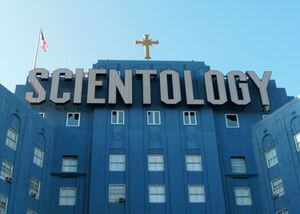Scientology
(Cult, Religion) | |
|---|---|
 | |
| Formation | May 1952 |
| Founder | L. Ron Hubbard |
| Headquarters | California, United States |
| Religion/Sect known for its hardball tactics against critics. | |
Scientology is a set of beliefs and practices invented by American author L. Ron Hubbard, and an associated movement. It has been variously defined as a cult, a business or a new religious movement. Hubbard initially developed a set of ideas, which he represented as a form of therapy, called Dianetics. This he promoted through various publications, and through the Hubbard Dianetic Research Foundation, which he established in 1950. The foundation soon entered bankruptcy, and Hubbard lost the rights to his book Dianetics: The Modern Science of Mental Health in 1952. He then recharacterized the subject as a religion and renamed it Scientology, retaining the terminology, doctrines, and the practice of "auditing".[1] Within a year, he regained the rights to Dianetics and retained both subjects under the umbrella of the Church of Scientology[2][3][4]
From soon after their formation, Hubbard's groups have generated considerable opposition and controversy, in some instances due to their illegal activities.[5] In January 1951, the New Jersey Board of Medical Examiners brought proceedings against the Dianetic Research Foundation on the charge of teaching medicine without a license.[6] During the 1970s Hubbard's followers engaged in a program of criminal infiltration of the U.S. government, resulting in several executives of the organization being convicted and imprisoned for multiple offenses by a U.S. Federal Court.[7] In 1992, a court in Canada convicted the Scientology organization in Toronto of spying on law enforcement and government agencies, and criminal breach of trust, later upheld by the Ontario Court of Appeal.[8][9] The Church of Scientology was convicted of fraud by a French court in 2009, a decision upheld by the supreme Court of Cassation in 2013.
The Church of Scientology has been described by government inquiries, international parliamentary bodies, scholars, law lords, and numerous superior court judgements as both a dangerous cult and a manipulative profit-making business.[10][11] Germany classifies Scientology groups as an "anti-constitutional sect",[12][13] while in France the government classify the group as a dangerous cult. A 1995 parliamentary report lists Scientology groups as cults, and in its 2006 report MIVILUDES similarly classified Scientology organizations as a dangerous cult[14]
Fair Game
The term Fair Game is used to describe policies and practices carried out by the Church of Scientology towards people and groups it perceives as its enemies. Founder of Scientology, L. Ron Hubbard, established the policy in the 1950s, in response to criticism both from within and outside his organization. Individuals or groups who are "Fair Game" are judged to be a threat to the Church and, according to the policy, can be punished and harassed using any and all means possible. In 1968, Hubbard officially canceled use of the term "Fair Game" because of negative public relations it caused, although the Church's aggressive response to criticism continued.
Applying the principles of Fair Game, Hubbard and his followers targeted many individuals as well as government officials and agencies, including a program of covert and illegal infiltration of the Internal Revenue Service (IRS) and other United States government agencies during the 1970s. They also conducted private investigations, character assassination and legal action against the Church's critics in the media. The policy remains in effect and has been defended by the Church of Scientology as a core religious practice.
Starting in the 1980s, for their major branch in Los Angeles, California, the Scientology organization largely switched from using church members in harassment campaigns to hiring private investigators, including former and current Los Angeles police officers. The reason seemed to be that this gave the church a layer of protection in case embarrassing tactics were used and made public.[15]
Membership
A 2001 survey estimated that 55,000 people in the United States claimed to be Scientologists. Worldwide estimates of Scientology's core practicing membership ranges between 100,000 and 200,000, mostly in the U.S., Europe, South Africa and Australia.[16] The 2008 American Religious Identification Survey found that the number of American Scientologists had dropped to 25,000.[17][18][19] A 2008 Trinity College survey concluded there were only 25,000 American Scientologists.[20] Scientology is also declining in the United Kingdom.[21] In 2011, high-level defector Jeff Hawkins estimated there were 40,000 Scientologists worldwide.
The highest ranking people in the Scientology hierarchy are the members of the Sea Organization, or Sea Org. The organization includes some 5,000 of Scientology's most dedicated adherents, who work for low pay, and sign a billion-year contract.[22]
Wikipedia is not affiliated with Wikispooks. Original page source here
An event carried out
| Event | Location | Description |
|---|---|---|
| Operation Snow White | US Canada Europe UK Hollywood Australia | Religious cult breaks into 100s of international government buildings to remove their own names, is not banned. |
References
- ↑ http://www.smi.org/features/glossary/
- ↑ https://archive.org/details/harpersencyclope00guil
- ↑ https://www.webcitation.org/5zAHQbeV2?url=http://www.uni-marburg.de/fb03/ivk/mjr/pdfs/1999/articles/kent1999.pdf
- ↑ http://cosmedia.freewinds.be/media/articles/es231006.html%7Caccess-date=March 3, 2013
- ↑ https://archive.org/details/insidescientolog0000reit
- ↑ https://web.archive.org/web/20160903232811/https://books.google.com/books?id=umep6P6dYLAC&pg=PA532
- ↑ https://en.wikisource.org/wiki/United_States_v._Heldt,_668_F.2d_1238_(D.C._Cir._1981)
- ↑ https://buffalonews.com/news/toronto-church-faces-heavy-fine-scientology-branch-is-convicted-of-spying-on-police-others/article_671948ed-5f3a-5867-bb1c-e56ba12bace1.html
- ↑ https://www.canlii.org/en/on/onca/doc/1997/1997canlii16226/1997canlii16226.html?resultIndex=38#document
- ↑ https://api.parliament.uk/historic-hansard/written-answers/1968/jul/25/scientology
- ↑ https://www.cs.cmu.edu/~dst/Cowen/audit/appeal.html
- ↑ http://www.spiegel.de/international/germany/hubbard-s-church-unconstitutional-germany-prepares-to-ban-scientology-a-522052.html
- ↑ http://www.assemblee-nationale.fr/rap-enq/r2468.asp
- ↑ http://tempsreel.nouvelobs.com/societe/20090525.OBS8000/le-point-sur-l-eglise-de-scientologie.html
- ↑ https://www.latimes.com/local/la-scientology062990x-story.html#page=1 On the Offensive Against an Array of Suspected Foes], Los Angeles Times, Joel Sappell, Robert W. Welkes, page A1, June 29, 1990. "Church spokesmen maintain that Hubbard rescinded the policy three years after it was written . . . . . But various judges and juries have concluded that while the actual labelling of persons as 'fair game' was abandoned, the harassment continued unabated."
- ↑ https://web.archive.org/web/20140331193434/http://www.rollingstone.com/culture/news/inside-scientology-20110208
- ↑ https://web.archive.org/web/20130514163850/http://www.nytimes.com/2010/11/10/business/10scientology.html%7Carchive-date=May 14, 2013
- ↑ https://www.villagevoice.com/2011/07/04/scientologists-how-many-of-them-are-there-anyway/
- ↑ https://www.nytimes.com/2010/03/07/us/07scientology.html
- ↑ https://www.thenation.com/article/clear-scientology/
- ↑ https://www.bbc.co.uk/news/uk-england-tyne-26936135
- ↑ Cowan, Douglas E.; Bromley, David G. (2006). "The Church of Scientology". In Gallagher, Eugene V.; Ashcraft, W. Michael (eds.) (2006). Introduction to New and Alternative Religions in America. 5. Westport CT: Greenwood Press. pp. 180